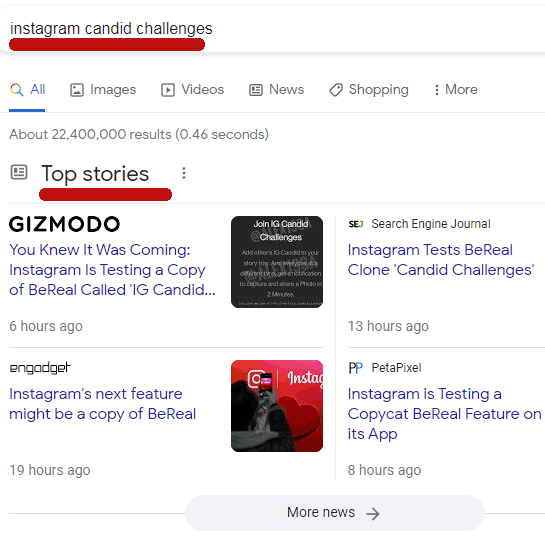Google updated its Article structured data guidelines to reflect that they dropped the AMP requirement and changed the image guidelines for Top Stories eligibility.
Three changes to the guidelines make it clear that eligibility for the top stories section that can dominate the top of the search results became accessible for more publishers.
Why Top Stories is Important
Top stories is a way for Google to feature fresh news content in the search results.
Searches on topics that are trending in the news will generate the top stories section, which surfaces at the top of the search results in sizes that can dominate the screen on mobile and desktop searches.
Screenshot of a Top Stories in Google Search

Top stories also can show lower down in the middle of the page.
Consequently, being shown in top stories is crucial to sites that publish breaking news.
Articles Structured Data Not Necessary for Top Stories
Something interesting is that Google added wording to the first paragraph of the Article structured data guidelines to note that structured data isn’t necessary to appear in top stories.
This is the new paragraph:
“Adding Article structured data to your news, blog, and sports article pages can help Google understand more about the web page and show better title text, images, and date information for the article in search results on Google Search and other properties (for example, Google News and the Google Assistant). While there’s no markup requirement to be eligible for Google News features like Top stories, you can add Article to more explicitly tell Google what your content is about (for example, that it’s a news article, who the author is, or what the title of the article is).”
Whether it’s always been the case that structured data was not necessary to be eligible, or if this is something new, it’s notable because it shows that Google’s documented requirements are less restrictive and more inclusive of a greater number of websites.
That means that news sources that don’t add article structured data can nevertheless be eligible to appear in top stories.
This is the case with other enhanced listings as well. So it’s not surprising that Google’s documentation for Top Stories should also follow the trend of no longer requiring structured data to qualify for an enhanced listing in the search results.
However, it is still a best practice to include structured data, including the Article Schema.org structured data, because it allows publishers to make it easier for Google to understand the web pages.
An example of a benefit of using the Article structured data is that a publisher can specify three images in different aspect ratios in a way that is clear for search engines to understand.
Google Deletes References To AMP
AMP, which stands for Accelerated Mobile Pages, is a framework for developing HTML pages that load extremely quickly on mobile devices.
The use of AMP was, at one time, necessary to qualify for inclusion in top stories.
That’s no longer the case, and Google removed AMP-related information from the Article structured data guidelines to reflect that change.
Google didn’t just change the guidelines to include AMP and non-AMP information. Google completely removed all references to AMP from the structured data guidelines.
Publishers who use AMP no longer have a reference from the Article structured data guidelines.
Google published an advance notice of this change in 2020 in a blog post:
“AMP will no longer be necessary for stories to be featured in Top Stories on mobile; it will be open to any page.”
Change To Top Stories Image Guidelines
Another change, which might be considered the most important, makes inclusion in top stories easier to achieve.
The change is to the image size. Google made the image size requirement smaller, which could be useful for publishers in that they can now use smaller images and achieve faster page speed scores.
Google’s structured data guidelines for images previously required high-resolution photos with a minimum of 800,000 pixels when the width and height were multiplied.
The following is what the guidelines specified before and after the change.
Before:
“For best results, provide multiple high-resolution images (minimum of 800,000 pixels when multiplying width and height) with the following aspect ratios: 16×9, 4×3, and 1×1.”
After:
“For best results, provide multiple high-resolution images (minimum of 50K pixels when multiplying width and height) with the following aspect ratios: 16×9, 4×3, and 1×1.”
Top Stories Guidelines
These changes may, on the surface, seem trivial. But they are significant.
The complete removal of any guide for publishers who use AMP is a little curious. It’s almost like Google is stepping back from AMP.
Google’s update to the image guidelines for top stories is a welcome change because it encourages using smaller image sizes, which is good for users and publishers.
Citations
Archive of Google’s Previous Article Structured Data Guidelines
Google’s Current Article Structured Data Guidelines
Featured image by Shutterstock/The Faces





![AI Overviews: We Reverse-Engineered Them So You Don't Have To [+ What You Need To Do Next]](https://www.searchenginejournal.com/wp-content/uploads/2025/04/sidebar1x-455.png)